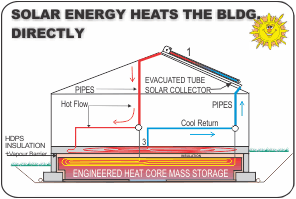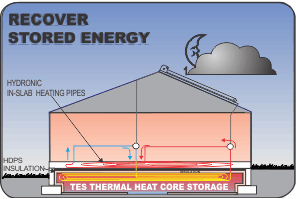How It Works

How does the Storage system work?



Physics tells you that to have enough solar heat in winter, the summer energy storage system must be huge.
The Basic
The key component in the DSH system is the Geo-based thermal storage or Heat core. It is sized to fit the footprint of the building as the size requirements to be able to absorb a full summer sun and store as much energy as possible, are huge MWt of energy can be stored.
As the diagrams and animation above show, the key to this inter-seasonal solar heating system is the patented huge, low cost, thermal storage battery system we call the heat core. As it typically encompasses the whole footprint of the building with a nominal engineered depth as required for the build location, it can store more than a years solar summer energy and release it on demand for winter, nights or dark days.
And, by using high tech evacuated tube solar collectors, the system provides heat in any sun, even in temperatures below -30c.
The DSH hydronic system also uses the inherent thermal mass of the concrete floor slab to additionally help store direct heat over longer periods of time.
The heat core storage is insulated on 5 or 6 sides, and always insulated from the slab to isolate it from conductive heat to the slab in summer, when heat is not required. It can take several years to fully charge the storage heat core.
Key Requirements
Another key ingredient is the engineering that goes into the solar array. The array is sized to fit the area that the solar system is located geographically, it is also sized for the physical location and the heat load of the building/home. The system is fully scalable from the smallest off grid home to the largest warehouse or recreational center.
Some consideration must be given to accommodating the solar system. Flat roofs are typically well positioned for solar thermal panels. However sloped roofs should be a devoid as possible from roof irregularities the compromise the optimal flat layout area or shadow same.
In addition, a custom controller system manages all the systems, based on your own input, in a hands off manner. Once operational, it should last decades with only nominal service much as you would with a gas furnace or any other hydronic heating system.
It is designed to offset 50-75% of your heating needs. Performance depends on budget, location, & engineering.
Where moderate winter temperatures are expected, or locations designed with high efficiency in mind, such as LEEDs certified buildings, and/or Net Zero designed buildings, the performance can be 100% offset for heat and >70% for hot water.
Retrofitting
As you can imagine, it can be difficult to retrofit a home or building with a DSH hydronic heating system, once a building has been built, but not impossible.
The key elements including the heated thermal mass floor, the storage heat core and solar array. They can often be retrofitted, but it can be more costly. Existing concrete or wooden floors can be covered using a special self leveling compound. The heat core can also be installed alongside existing buildings when space allows.
In homes/buildings already heated with radiant hydronic heating, retrofitting can much easier. Each location would need to be investigated and estimated on a case by case basis.
Corporate Office Locations
Calgary, Alberta, Canada
Langley, British Columbia, Canada
Wellington, NZ
Phone
(587) 351 6020
info@digitalsolarheat.com
